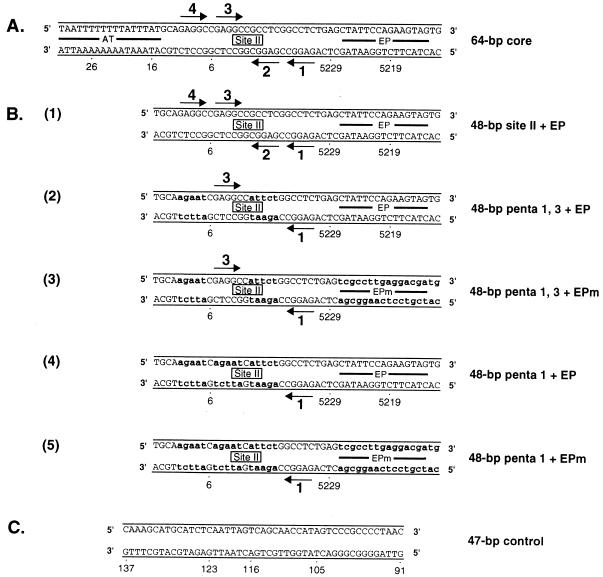FIG. 1.
Sequences of the 64-bp core oligonucleotide and a set of oligonucleotides derived from the site II + EP oligonucleotide. (A) The 64-bp core origin; locations of the AT, site II, and the EP regions are indicated. Arrows depict the four GAGGC pentanucleotides within site II that serve as recognition sites for T-ag; pentanucleotides are numbered as previously described (38). SV40 sequences are numbered as described elsewhere (72). (B) Sequences of a set of oligonucleotides based on the 48-bp site II + EP oligonucleotide. The sequence of the 48-bp site II + EP oligonucleotide is presented in diagram 1. Diagram D2 presents the sequence of the 48-bp penta 1, 3 + EP oligonucleotide, a representative member of the two pentanucleotide + EP set of oligonucleotides. During the synthesis of the 48-bp penta 1, 3 + EP oligonucleotide, transition mutations were introduced at pentanucleotides 2 and 4. These mutations are indicated by the lowercase bold letters. Although not depicted, the 48-bp penta 1, 2 + EP, penta 1, 4 + EP, penta 2, 3 + EP, penta 2, 4 + EP, and penta 3, 4 + EP oligonucleotides were also synthesized. Diagram D3 presents the sequence of the 48-bp penta 1, 3 + EPm oligonucleotide. This oligonucleotide is similar to the 48-bp penta 1, 3 + EP oligonucleotide except that additional transition mutations have replaced the EP region (symbolized by lowercase bold letters). A representative member of the single pentanucleotide + EP set of oligonucleotides, the 48-bp penta 1 + EP oligonucleotide, is presented in diagram 4. During synthesis of this oligonucleotide, transition mutations were introduced at pentanucleotides 2, 3, and 4 (indicated by lowercase bold letters). The sequence of the 48-bp penta 1 + EPm oligonucleotide is presented in diagram 5; this molecule is similar to the 48-bp penta 1 + EP oligonucleotide except that additional transition mutations have replaced the EP region (indicated by lowercase bold letters). Although not depicted, the 48-bp penta 3 + EP and 48-bp penta 3 + EPm oligonucleotides were also synthesized. (C) Finally, the sequence of the 47-bp control oligonucleotide is presented; this molecule served as a control for non-sequence-specific binding events.

